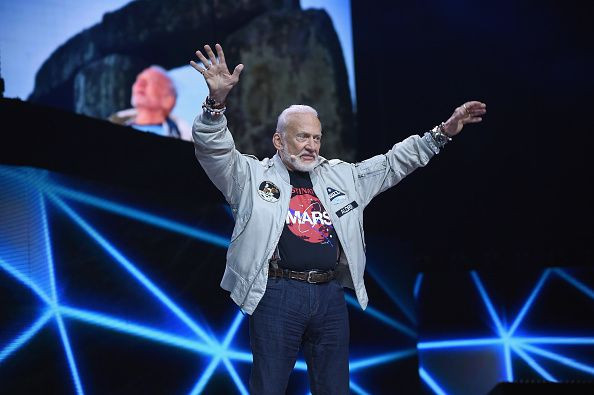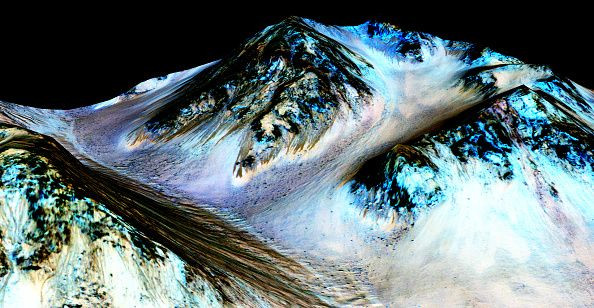How Much Does It Cost To Go To Mars? Buzz Aldrin Is Raising Money To Make It Cheaper

NASA admitted earlier this month that it currently does not have the funds available to send humans to Mars and back. Astronaut Buzz Aldrin took matters into his own hands and announced Saturday at a Kennedy Space Center gala that he would raise money for travel to Mars, reported the Associated Press Sunday.
Both NASA and Aldrin agreed that sending humans to Mars by 2040 is an attainable goal. At the ShareSpace Foundation gala, Aldrin, 87, commemorated the 48th anniversary of his 1969 moon landing. He announced he raised more than $190,000 for his non-profit space education foundation, ShareSpace Foundation.
The ShareSpace Foundation presented Jeff Bezos, the founder of Amazon and the company Blue Origin, with the first Buzz Aldrin Space Innovation Award. Bezos said he would use a portion of his money to lower the cost of space travel with reusable space rockets.
Read: NASA Admits It Can't Afford To Land Humans On Mars
The Mars One organization, a private organization founded in the Netherlands, said they would send humans to Mars and establish a permanent colony there by 2035.
“Mars One estimates the cost of bringing the first four people to Mars at US$ 6 billion. This is the cost of all the hardware combined, plus the operational expenditures, plus margins,” read organization’s estimated budget on its website. “For every next manned mission including hardware and operations, Mars One estimates the costs at US$ 4 billion.”
NASA also began the first stages of creating the Space Launch System and the Orion spacecraft in order to send humans into space. NASA developed its Space Launch System and the Orion spacecraft to further the goal of sending humans to Mars, but it would also need to design landing vehicles with the capability to both land and ascend, according to Technica.
“I can’t put a date on humans on Mars, and the reason really is the other piece is, at the budget levels we described, this roughly 2 percent increase, we don’t have the surface systems available for Mars,” said William H. Gerstenmaier, head of human spaceflight at NASA. “And that entry, descent and landing is a huge challenge for us to Mars.”
Pascal Lee, director of the Mars Institute, a non-profit research organization that NASA partially funds, spoke to TIME in May 2017 and broke down the estimated cost of NASA sending someone to Mars. He compared the proposed mission of sending people to Mars to the Apollo lunar landing program, which cost $24 billion in 1960s dollar value over 10 years.
NASA utilized 4 percent of U.S. GDP for the Apollo lunar landing program. Lee said that the United States Defense Department spent $24 billion a year during the Vietnam War, adding, “So basically, going to the moon with funding spread over 10 years cost the same to run the Department of Defense for one year in wartime.”
Today’s current NASA budget is placed at $19.5 billion a year, which is a negligible portion of the GDP.
“Doing a human mission to Mars “the government way” could not cost less than $400 billion,” Lee said. This is going to Mars, so you multiply that by a factor of 2 or 3 in terms of complexity, you’re talking about $1 trillion, spread over the course of the next 25 years.”
At Saturday’s gala, Aldrin continued his message of the future of space travel.
“I like to think of myself as an innovative futurist. The programs we have right now are eating up every piece of the budget and it has to be reduced if we’re ever going to get anywhere,” he said.
Read: Elon Musk's SpaceX vs. NASA: Who Will Send Tourists To Space First?
Although Aldrin and NASA made progress in the space travel planning phase, Elon Musk’s SpaceX has established itself as one of the only organizations with the financial possibility of sending humans to Mars in the near future.

The race to Mars escalated after notable figures such as Elon Musk and Stephen Hawking spoke about the importance of colonizing space. In a paper he published in the scientific journal New Space, Musk discussed the possibility of a self-sustaining city on Mars.
“History is going to bifurcate along two directions. One path is we stay on Earth forever, and then there will be some sort of eventual extinction event,” Musk said, according to the Deccan Chronicle.
Hawking echoed similar sentiments at the Starmus Science Festival in Trondheim, Norway. He addressed the possibility of Earth's impending destruction by factors such as overpopulation or an asteroid strike.
“I am convinced that humans need to leave Earth. The earth is becoming too small for us,” he said. “When we have reached a similar crisis in our history, there has usually been somewhere else to colonize. We are running out of space and the only places to go are other worlds.”
© Copyright IBTimes 2024. All rights reserved.




















